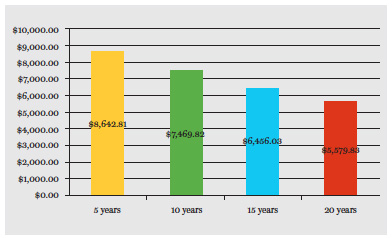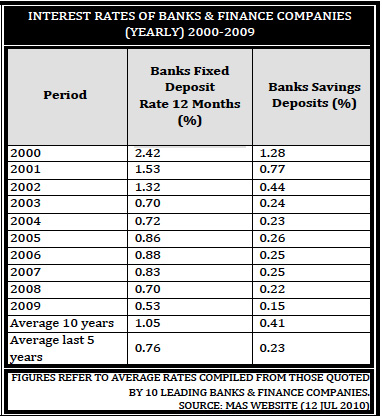Beyond saving, there is the need to know how to save wisely so that the value of hard earned money is not eroded by inflation.
Contributed By Mervyn Song
 |
| Illustration 1 |
What happens if you simply leave your hard-earned money in a savings account that just pays you an interest of 0.125 percent? Take a look at the impact of inflation on $10,000 over time (assuming an inflation rate of 3 percent). See illustration 1. As you can see, over a period of 20 years, you will probably lose almost 50 percent of your purchasing power. My point from this illustration? Don’t leave your hard earned money to the ravages of inflation!
At the end of the day, it is not what we earn that makes us rich; it is what we save that does. While saving is important, it is even more crucial to consider what we do with what we save.
Two important tips:
1. Set a base savings rate every month and never go below that.
2. Income growth should never imply an equal increase in expenditure.
As the saying goes, we save for a rainy day. But we can also maximize the potential of these emergency funds to prove more effective for us in the long run.
First, let’s have a look at what the banks are offering us. If you are thinking to yourself, “Don’t the rates look too low?” You are right! And they are likely to stay low as central banks around the world try to kickstart their economy by making borrowing cheap. It then becomes imperative that we seek out instruments that can yield returns at least equivalent or more than the inflation rate, while fitting our risk profile. Some options that we can consider are:
 Single Premium Endowment Plans: These are single premium plans that work akin to fixed deposits, but on a longer time frame (generally five to 20 years). The potential yield that some of these plans offer now can be as high as 3.03 percent per annum.
Single Premium Endowment Plans: These are single premium plans that work akin to fixed deposits, but on a longer time frame (generally five to 20 years). The potential yield that some of these plans offer now can be as high as 3.03 percent per annum.
While some may consider the 5-year lock-in period too long, take some time to consider your own habits: Do you also just renew your deposits when they mature?
Others are concerned about the possibility of the interest rate environment changing against you. Interest rates only move in three ways—up, down, or they remain the same. In the event that interest rises, the question then is, how steeply does it rise? More often than not, the rises are gradual, which still benefits you in the long term. Looking at the interest rates table (illustration 2) would show you that the year-on-year changes are quite minimal.
Bonds: These are basically debts issued by corporations or governments. It generally pays a higher rate than savings or deposits to entice investors. However, the tenure tends to be longer, in the range of five to 10 years. The dividend potential of the bond issue is generally pegged to the perceived risk level of the issuing company or government. However, there are risks involved:
• The principal amount you put in is not guaranteed and investors could get back less than the initial amount invested. This could happen in various scenarios, but the most common one would be during an increase in the savings and deposits rate.
• It could require a higher cash outlay for participation.
• Should there be a default of the issuer or bankruptcy, there could be a possibility that the investor gets back nothing.
• If the secondary bond market is weak, investors could find this form of investment illiquid.
Dividend Yielding Instruments: High yielding stocks is one good alternative that one could invest into. However, basic research as to the viability of the underlying stock has to be done to determine growth potential, the track record of dividend payout history and performance in good or bad market conditions. The balance sheet would also be able to tell a story. In today’s context, a balance sheet strong in liquidity and cashflow with little or no debt would probably mean that even in bad market conditions, dividend obligations could still be met.
Central Provident Fund: One school of thought would consider CPF accounts as a form of savings. Depositing excess cash into your CPF would probably earn you a higher interest, but do consider the other side of the coin – those monies become “untouchable” once it is deposited into CPF. Only when you turn 55 can you withdraw your CPF savings, and even then, subject to meeting the requirements of your Minimum Sum Scheme.
While there are various alternatives to savings and deposits, the apportionment of available funds to be put in really depends on four simple considerations:
 |
| Illustration 2 |
Purpose. This would give you the purpose behind the purpose. Yes, the purpose is to save, but what are you saving towards? A wedding, downpayment for a new property, retirement? Having a goal to save provides the specifics to savings, like when do you need the funds? What type of investment vehicles can bring you there? Otherwise, it would be just saving for saving’s sake, and you will lose that motivation after a while. And we all know that nothing gets done without motivation.
Time Horizon. If you have a relatively long time horizon (more than five years) during which you do not need to access the funds, then you could go for higher-returns-higher-risk investments. As market cycles get shorter, it is imperative that you have time on your side.
Risk Profile. What kind of loss can you stomach? We are not talking about risk you think you can stomach, but really, what level of loss results in sleepless nights for you? While high returns are very tempting, the flip side is that you could also lose big. So can you afford it?
Asset Allocation. As the saying goes, do not put all your eggs in one basket no matter how attractive that asset class seems. Diversify across growth, dividend generating and capital preservation asset classes, because this provides stability in different market conditions.
Ultimately, the main reason why we seek various alternatives for our savings is to preserve the purchasing power of every dollar saved. In fact, not just preserving, but enhancing that purchasing power to ensure that your money works harder for you.
Mervyn Song is a Certified Financial Planner (CM) Practitioner. All views expressed are his own and do not represent City News.
